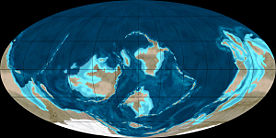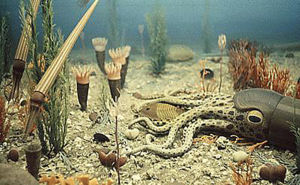Ordovician
2008/9 Schools Wikipedia Selection. Related subjects: Geology and geophysics
| Ordovician period 488.3 - 443.7 million years ago ↓
|
|
 |
|
| Mean atmospheric O2 content over period duration | ca. 13.5 Vol % (68 % of modern level) |
| Mean atmospheric CO2 content over period duration | ca. 4200 ppm (15 times pre-industrial level) |
| Mean surface temperature over period duration | ca. 16°C (2°C above modern level) |
|
Key events in the Ordovician
view • discuss •
-490 —
–
-485 —
–
-480 —
–
-475 —
–
-470 —
–
-465 —
–
-460 —
–
-455 —
–
-450 —
–
-445 —
–
←
First land plant spores
O
r d o v i c i a n Palæozoic
Key events of the Ordovician period.
Left: ICS approved stages. Right: "General" stages. Axis scale: millions of years ago. |
|
The Ordovician is a geologic period, the second of six of the Paleozoic era, and covers the time between 488.3±1.7 to 443.7±1.5 million years ago ( ICS, 2004). It follows the Cambrian period and is followed by the Silurian period. The Ordovician, named after the Welsh tribe of the Ordovices, was defined by Charles Lapworth in 1879, to resolve a dispute between followers of Adam Sedgwick and Roderick Murchison, who were placing the same rock beds in northern Wales into the Cambrian and Silurian periods respectively. Lapworth, recognizing that the fossil fauna in the disputed strata were different from those of either the Cambrian or the Silurian periods, realized that they should be placed in a period of their own.
While recognition of the distinct Ordovician period was slow in the United Kingdom, other areas of the world accepted it quickly. It received international sanction in 1906, when it was adopted as an official period of the Paleozoic era by the International Geological Congress.
Ordovician dating
The Ordovician period started at a major extinction event called the Cambrian-Ordovician extinction events some time about 488.3 ± 1.7 million years ago ( Ma) and lasted for about 44.6 million years. It ended with another major extinction event about 443.7 ± 1.5 Ma (ICS, 2004) that wiped out 60% of marine genera. A. Melott et al. (ref. 2006) suggested a ten-second gamma ray burst could have destroyed the ozone layer and exposed terrestrial and marine surface-dwelling life to deadly radiation, but most scientists agree that extinction events are complex with multiple causes. See below.
The dates given are recent radiometric dates and vary slightly from those used in other sources. This second period of the Paleozoic era created abundant fossils and in some regions, major petroleum and gas reservoirs.
Ordovician subdivisions
The Ordovician Period is usually broken into Early ( Tremadoc and Arenig), Middle ( Llanvirn [subdivided into Abereiddian and Llandeilian]) and Late ( Caradoc and Ashgill) epochs. The corresponding rocks of the Ordovician System are referred to as coming from the Lower, Middle, or Upper part of the column. The faunal stages (subdivisions of epochs) from youngest to oldest are:
- Hirnantian/Gamach (Late Ordovician: Ashgill)
- Rawtheyan/Richmond (Late Ordovician: Ashgill)
- Cautleyan/Richmond (Late Ordovician: Ashgill)
- Pusgillian/Maysville/Richmond (Late Ordovician: Ashgill)
- Trenton (Middle Ordovician: Caradoc)
- Onnian/Maysville/Eden (Middle Ordovician: Caradoc)
- Actonian/Eden (Middle Ordovician: Caradoc)
- Marshbrookian/Sherman (Middle Ordovician: Caradoc)
- Longvillian/Sherman (Middle Ordovician: Caradoc)
- Soundleyan/Kirkfield (Middle Ordovician: Caradoc)
- Harnagian/Rockland (Middle Ordovician: Caradoc)
- Costonian/Black River (Middle Ordovician: Caradoc)
- Chazy (Middle Ordovician: Llandeilo)
- Llandeilo (Middle Ordovician: Llandeilo)
- Whiterock (Middle Ordovician: Llanvirn)
- Llanvirn (Middle Ordovician: Llanvirn)
- Cassinian (Early Ordovician: Arenig)
- Arenig/Jefferson/Castleman (Early Ordovician: Arenig)
- Tremadoc/Deming/Gaconadian (Early Ordovician: Tremadoc)
Ordovician paleogeography
Sea levels were high during the Ordovician; in fact during the Tremadocian, marine transgressions worldwide were the greatest for which evidence is preserved in the rocks.
During the Ordovician, the southern continents were collected into a single continent called Gondwana. Gondwana started the period in equatorial latitudes and, as the period progressed, drifted toward the South Pole. Early in the Ordovician, the continents Laurentia, Siberia, and Baltica were still independent continents (since the break-up of the supercontinent Pannotia earlier), but Baltica began to move towards Laurentia later in the period, causing the Iapetus Ocean to shrink between them. Also, Avalonia broke free from Gondwana and began to head north towards Laurentia. Rheic Ocean was formed as a result of this.
Ordovician rocks are chiefly sedimentary. Because of the restricted area and low elevation of solid land, which set limits to erosion, marine sediments that make up a large part of the Ordovician system consist chiefly of limestone. Shale and sandstone are less conspicuous.
A major mountain-building episode was the Taconic orogeny that was well under way in Cambrian times.
By the end of the period, Gondwana had neared or approached the pole and was largely glaciated.
The Ordovician was a time of calcite sea geochemistry in which low-magnesium calcite was the primary inorganic marine precipitate of calcium carbonate. Carbonate hardgrounds were thus very common, along with calcitic ooids, calcitic cements, and invertebrate faunas with dominantly calcitic skeletons (Stanley and Hardie, 1998, 1999).
Climate
The Early Ordovician climate was thought to be quite warm, at least in the tropics. As with North America and Europe, Gondwana was largely covered with shallow seas during the Ordovician. Shallow clear waters over continental shelves encouraged the growth of organisms that deposit calcium carbonates in their shells and hard parts. Panthalassic Ocean covered much of the northern hemisphere, and other minor oceans included Proto-Tethys, Paleo-Tethys, Khanty Ocean which was closed off by the Late Ordovician, Iapetus Ocean, and the new Rheic Ocean.
As the Ordovician progressed, we see evidence of glaciers on the land we now know as Africa and South America. At the time these land masses were sitting at the South Pole, and covered by ice caps.
Ordovician Life
Ordovician fauna
Though less famous than the Cambrian explosion, the Ordovician featured an adaptive radiation that was no less remarkable; marine faunal genera increased fourfold, resulting in 12% of all known Phanerozoic marine fauna. The trilobite, inarticulate brachiopod, archaeocyathid, and eocrinoid faunas of the Cambrian were succeeded by those which would dominate for the rest of the Paleozoic, such as articulate brachiopods, cephalopods, and crinoids; articulate brachiopods, in particular, largely replaced trilobites in shelf communities. Their success epitomizes the greatly increased diversity of carbonate shell-secreting organisms in the Ordovician compared to the Cambrian.
In North America and Europe, the Ordovician was a time of shallow continental seas rich in life. Trilobites and brachiopods in particular were rich and diverse. The first bryozoa appeared in the Ordovician as did the first coral reefs. Solitary corals date back to at least the Cambrian. Molluscs, which had also appeared during the Cambrian or the Ediacaran, became common and varied, especially bivalves, gastropods, and nautiloid cephalopods. It was long thought that the first true vertebrates (fish - Ostracoderms) appeared in the Ordovician, but recent discoveries in China reveal that they probably originated in the Early Cambrian. The very first jawed fish appeared in the Late Ordovician epoch. Now-extinct marine animals called graptolites thrived in the oceans. Some cystoids and crinoids appeared.
During the Middle Ordovician there was a large increase in the intensity and diversity of bioeroding organisms. This is known as the Ordovician Bioerosion Revolution (Wilson & Palmer, 2006). It is marked by a sudden abundance of hard substrate trace fossils such as Trypanites, Palaeosabella and Petroxestes.
Trilobites in the Ordovician were very different than their predecessors in the Cambrian, Many trilobites developed bizarre spines and nodules to defend against predators such as primitive sharks and Nautiloid cephalopods while other trilobites such as Aeglina prisca evolved to become swimming forms. Some trilobites even developed shovel-like snouts for ploughing through muddy sea bottoms. Another unusual clade of trilobites known as the Trinucleids developed a broad pitted margin around their head shields.
Other trilobites such as ( Asaphus kowalewski) evolved long eyestalks to assist in detecting predators while some trilobite eyes by contrast took the opposing evolutionary direction and disappeared completely.
Ordovician flora
Green algae were common in the Ordovician and Late Cambrian (perhaps earlier). Plants probably evolved from green algae. The first terrestrial plants appeared in the form of tiny non-vascular plants resembling liverworts. Fossil spores from land plants have been identified in uppermost Ordovician sediments, but among the first land fungi may have been Arbuscular mycorrhiza fungi ( Glomerales), playing a crucial role in facilitating the colonization of land by plants through mycorrhizal symbiosis, which makes mineral nutrients available to plant cells; such fossilized fungal hyphae and spores from the Ordovician of Wisconsin have been found with an age of about 460 mya, a time when the land flora most likely only consisted of plants similar to non-vascular bryophytes.
Marine fungi were abundant in the Ordovician seas to decompose animal carcasses, and other wastes.
End of the Ordovician
The Ordovician came to a close in a series of extinction events that, taken together, comprise the second largest of the five major extinction events in Earth's history in terms of percentage of genera that went extinct. The only larger one was the Permian-Triassic extinction event.
The extinctions occurred approximately 444-447 million years ago and mark the boundary between the Ordovician and the following Silurian Period. At that time all complex multicellular organisms lived in the sea, and about 49% of genera of fauna disappeared forever; brachiopods and bryozoans were decimated, along with many of the trilobite, conodont and graptolite families.
The most commonly accepted theory is that these events were triggered by the onset of an ice age, in the Hirnantian faunal stage that ended the long, stable greenhouse conditions typical of the Ordovician. The ice age was probably not as long-lasting as once thought; study of oxygen isotopes in fossil brachiopods shows that it was probably no longer than 0.5 to 1.5 million years. The event was preceded by a fall in atmospheric carbon dioxide (from 7000ppm to 4400ppm) which selectively affected the shallow seas where most organisms lived. As the southern supercontinent Gondwana drifted over the South Pole, ice caps formed on it, which have been detected in Upper Ordovician rock strata of North Africa and then-adjacent northeastern South America, which were south-polar locations at the time.
Glaciation locks up water from the world-ocean, and the interglacials free it, causing sea levels repeatedly to drop and rise; the vast shallow intra-continental Ordovician seas withdrew, which eliminated many ecological niches, then returned carrying diminished founder populations lacking many whole families of organisms, then withdrew again with the next pulse of glaciation, eliminating biological diversity at each change. Species limited to a single epicontinental sea on a given landmass were severely affected. Tropical lifeforms were hit particularly hard in the first wave of extinction, while cool-water species were hit worst in the second pulse.
Surviving species were those that coped with the changed conditions and filled the ecological niches left by the extinctions.
At the end of the second event, melting glaciers caused the sea level to rise and stabilise once more. The rebound of life's diversity with the permanent re-flooding of continental shelves at the onset of the Silurian saw increased biodiversity within the surviving Orders.
